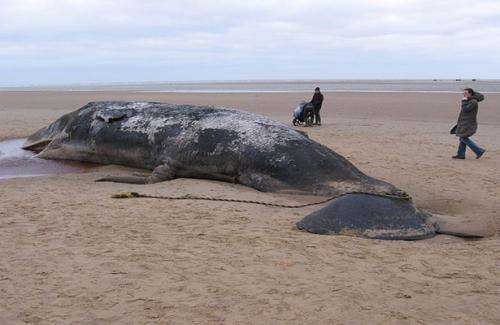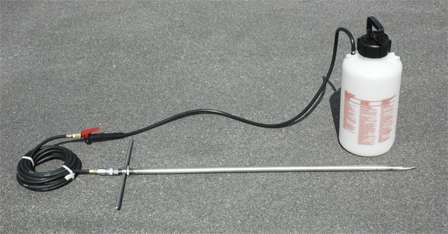When whales can't be rescued

Each year between one and five large whales beach themselves along the North Carolina coast. Most of these whales are already dead, and the others beach because they are usually too sick or injured to survive. Rescue in these cases is not an option. But death for a beached whale is a horrible process that can involve days of suffering.
NC State's Craig Harms, an aquatic wildlife veterinarian, witnessed this suffering firsthand and wanted to find a way to help these stranded animals. He teamed up with marine mammal experts Bill McLellan from UNC-Wilmington, Michael Moore from Woods Hole Oceanographic Institution, and Susan Barco from the Virginia Aquarium, to develop a humane way to deliver euthanasia drugs to beached whales.
If you're wondering how hard it can be to euthanize a whale, the answer is, "Hard."
Whales are big. That's obvious. But their size makes drug delivery tricky, especially when you need to deliver a lethal dose. That's because you aren't just dosing a whale – you're also potentially dosing every scavenger that comes into contact with its carcass. For that reason pentobarbital, the normal drug of choice for euthanasia, isn't useful. Pentobarbital can stick around in marine environments, posing a poisoning risk to a number of other, healthy animals.
Then there's the question of how you even get the drugs where they need to go. Harms and McLellan had to design and manufacture their own needles: a nearly foot-long (30 centimeter) needle to administer drugs intramuscularly, and a one meter (or 39.37 inch) needle that could reach the heart. The drugs are placed in a garden sprayer and pumped into the needle via rubber tubing.

Finally, they developed the protocol. The whale is first given a cocktail of sedatives and analgesics – midazolam, acepromazine and xylazine – to relieve pain, calm the animal and make it safer to work around (obviously, the space around a live, large, partially submerged whale is not a particularly safe working environment). The first drug is commonly used as a pre-anesthetic in humans as well as in veterinary medicine. The latter two are commonly used in large-animal sedation and anesthesia, so are readily available, reasonably inexpensive, and pose less risk to scavengers. Finally, potassium chloride (KCl) is injected directly into the heart. KCl is an inexpensive, simple and natural salt that stops the heart and doesn't pose a danger to any scavengers.
Harms and his colleagues published four separate case reports using this method in the current Journal of Wildlife Diseases.
"It really takes only one live whale-stranding experience for someone to be gripped by the magnitude of the challenges and need for humane and environmentally responsible options," says Harms. "It is a gut-wrenching experience to see a live whale on a beach, irreparably compromised, and not have a good means to relieve suffering. As sad as each case was individually, it was a relief to have a technique that worked humanely and minimized the potential impact to scavengers."
More information: Craig A. Harms, William A. McLellan, Michael J. Moore, Susan G. Barco, Elsburgh O.Clarke, III, Victoria G. Thayer, and Teresa K. Rowles (2014) LOW-RESIDUE EUTHANASIA OF STRANDED MYSTICETES. Journal of Wildlife Diseases: January 2014, Vol. 50, No. 1, pp. 63-73.
Provided by North Carolina State University




















